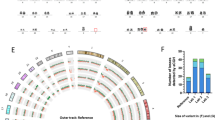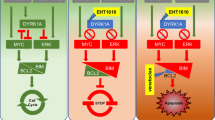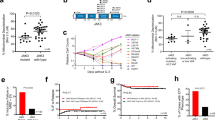Abstract
T-cell acute lymphoblastic leukaemia (T-ALL) is a challenging malignancy with a high relapse rate attributed to drug resistance. Tetrandrine (TET), a bisbenzylisoquinoline alkaloid extracted from a Chinese herb, is a potential anti-cancer and anti-leukaemic drug. In this study we investigated the mechanisms of TET resistance in T-ALL cells in vitro. Among the four T-ALL cell lines tested, Jurkat and CEM cells exhibited the lowest and highest resistance to TET with IC50 values at 24 h of 4.31±0.12 and 16.53±3.32 μmol/L, respectively. When treated with TET, the activity of transcription factor activator protein 1 (AP-1) was significantly decreased in Jurkat cells but nearly constant in CEM cells. To avoid cell-specific variation in drug resistance and transcription factor activities, we established a TET-R Jurkat subclone with the estimated IC50 value of 10.90±.92 μmol/L by exposing the cells to increasing concentrations of TET. Interestingly, when treated with TET, TET-R Jurkat cells exhibited enhanced AP-1 and NF-κB activity, along with upregulation of c-Jun N-terminal kinase (JNK) and extracellular signal-regulated kinase (ERK) signaling pathways, whereas the expression of P-gp was not altered. Selective inhibition of JNK but not ERK suppressed AP-1 activity and TET resistance in TET-R Jurkat cells and in CEM cells. These results demonstrate that Jurkat cells acquire TET resistance through activation of the JNK/AP-1 pathway but not through P-gp expression. The JNK/AP-1 pathway may be a potential therapeutic target in relapsed T-ALL.
Similar content being viewed by others
Log in or create a free account to read this content
Gain free access to this article, as well as selected content from this journal and more on nature.com
or
References
Hunger SP, Mullighan CG . Acute lymphoblastic leukemia in children. N Engl J Med 2015; 373: 1541–52.
Bhojwani D, Pui CH . Relapsed childhood acute lymphoblastic leukaemia. Lancet Oncol 2013; 14: e205–17.
Passaro D, Quang CT, Ghysdael J . Microenvironmental cues for T-cell acute lymphoblastic leukemia development. Immunol Rev 2016; 271: 156–72.
Swerts K, De Moerloose B, Dhooge C, Laureys G, Benoit Y, Philippe J . Prognostic significance of multidrug resistance-related proteins in childhood acute lymphoblastic leukaemia. Eur J Cancer 2006; 42: 295–309.
Kwan CY, Achike FI . Tetrandrine and related bis-benzylisoquinoline alkaloids from medicinal herbs: cardiovascular effects and mechanisms of action. Acta Pharmacol Sin 2002; 23: 1057–68.
Lai JH . Immunomodulatory effects and mechanisms of plant alkaloid tetrandrine in autoimmune diseases. Acta Pharmacol Sin 2002; 23: 1093–101.
Ho LJ, Lai JH . Chinese herbs as immunomodulators and potential disease-modifying antirheumatic drugs in autoimmune disorders. Curr Drug Metab 2004; 5: 181–92.
Liu T, Liu X, Li W . Tetrandrine, a Chinese plant-derived alkaloid, is a potential candidate for cancer chemotherapy. Oncotarget 2016; 7: 40800–15.
Mei L, Chen Y, Wang Z, Wang J, Wan J, Yu C, et al. Synergistic anti-tumour effects of tetrandrine and chloroquine combination therapy in human cancer: a potential antagonistic role for p21. Br J Pharmacol 2015; 172: 2232–45.
Liu B, Wang T, Qian X, Liu G, Yu L, Ding Y . Anticancer effect of tetrandrine on primary cancer cells isolated from ascites and pleural fluids. Cancer Lett 2008; 268: 166–75.
Wu JM, Chen Y, Chen JC, Lin TY, Tseng SH . Tetrandrine induces apoptosis and growth suppression of colon cancer cells in mice. Cancer Lett 2010; 287: 187–95.
Xu WL, Shen HL, Ao ZF, Chen BA, Xia W, Gao F, et al. Combination of tetrandrine as a potential-reversing agent with daunorubicin, etoposide and cytarabine for the treatment of refractory and relapsed acute myelogenous leukemia. Leuk Res 2006; 30: 407–13.
Libermann TA, Zerbini LF . Targeting transcription factors for cancer gene therapy. Curr Gene Ther 2006; 6: 17–33.
Lai JH, Ho LJ, Lu KC, Chang DM, Shaio MF, Han SH . Western and Chinese antirheumatic drug-induced T cell apoptotic DNA damage uses different caspase cascades and is independent of Fas/Fas ligand interaction. J Immunol 2001; 166: 6914–24.
Lai JH, Ho LJ, Kwan CY, Chang DM, Lee TC . Plant alkaloid tetrandrine and its analog block CD28-costimulated activities of human peripheral blood T cells: potential immunosuppressants in transplantation immunology. Transplantation 1999; 68: 1383–92.
Yang SP, Ho LJ, Lin YL, Cheng SM, Tsao TP, Chang DM, et al. Carvedilol, a new antioxidative beta-blocker, blocks in vitro human peripheral blood T cell activation by downregulating NF-kappaB activity. Cardiovasc Res 2003; 59: 776–87.
Liou JT, Chen ZY, Ho LJ, Yang SP, Chang DM, Liang CC, et al. Differential effects of triptolide and tetrandrine on activation of COX-2, NF-kappaB, and AP-1 and virus production in dengue virus-infected human lung cells. Eur J Pharmacol 2008; 589: 288–98.
Hayden MS . A less-canonical, canonical NF-kappaB pathway in DCs. Nat Immunol 2012; 13: 1139–41.
Zhao WL . Targeted therapy in T-cell malignancies: dysregulation of the cellular signaling pathways. Leukemia 2010; 24: 13–21.
Greaves MF . Differentiation-linked leukemogenesis in lymphocytes. Science 1986; 234: 697–704.
Burger R, Hansen-Hagge TE, Drexler HG, Gramatzki M . Heterogeneity of T-acute lymphoblastic leukemia (T-ALL) cell lines: suggestion for classification by immunophenotype and T-cell receptor studies. Leuk Res 1999; 23: 19–27.
Minowada J, Onuma T, Moore GE . Rosette-forming human lymphoid cell lines. I. Establishment and evidence for origin of thymus-derived lymphocytes. J Natl Cancer Inst 1972; 49: 891–5.
Smith SD, Shatsky M, Cohen PS, Warnke R, Link MP, Glader BE . Monoclonal antibody and enzymatic profiles of human malignant T-lymphoid cells and derived cell lines. Cancer Res 1984; 44: 5657–60.
Merlo LM, Pepper JW, Reid BJ, Maley CC . Cancer as an evolutionary and ecological process. Nat Rev Cancer 2006; 6: 924–35.
Baud V, Karin M . Is NF-kappaB a good target for cancer therapy? Hopes and pitfalls. Nat Rev Drug Discov 2009; 8: 33–40.
Shaulian E . AP-1 — The Jun proteins: Oncogenes or tumor suppressors in disguise? Cell Signal 2010; 22: 894–9.
Ritke MK, Bergoltz VV, Allan WP, Yalowich JC . Increased c-jun/AP-1 levels in etoposide-resistant human leukemia K562 cells. Biochem Pharmacol 1994; 48: 525–33.
Chen DW, Saha V, Liu JZ, Schwartz JM, Krstic-Demonacos M . Erg and AP-1 as determinants of glucocorticoid response in acute lymphoblastic leukemia. Oncogene 2013; 32: 3039–48.
Chen-Deutsch X, Garay E, Zhang J, Harrison JS, Studzinski GP . c-Jun N-terminal kinase 2 (JNK2) antagonizes the signaling of differentiation by JNK1 in human myeloid leukemia cells resistant to vitamin D. Leuk Res 2009; 33: 1372–8.
Herr I, Debatin KM . Cellular stress response and apoptosis in cancer therapy. Blood 2001; 98: 2603–14.
Xie JY, Chen N, Ren H, Wang WM . Angiotensin II-mediated activation of fibrotic pathways through ERK1/2 in rat peritoneal mesothelial cells. Ren Fail 2010; 32: 871–9.
Pritchard AL, Hayward NK . Molecular pathways: mitogen-activated protein kinase pathway mutations and drug resistance. Clin Cancer Res 2013; 19: 2301–9.
Leung KT, Li KK, Sun SS, Chan PK, Ooi VE, Chiu LC . Activation of the JNK pathway promotes phosphorylation and degradation of BimEL — a novel mechanism of chemoresistance in T-cell acute lymphoblastic leukemia. Carcinogenesis 2008; 29: 544–51.
Martel J, Payet MD, Dupuis G . The MDR1 (P-glycoprotein) and MRP (P-190) transporters do not play a major role in the intrinsic multiple drug resistance of Jurkat T lymphocytes. Leuk Res 1997; 21: 1077–86.
Estes DA, Lovato DM, Khawaja HM, Winter SS, Larson RS . Genetic alterations determine chemotherapy resistance in childhood T-ALL: modelling in stage-specific cell lines and correlation with diagnostic patient samples. Br J Haematol 2007; 139: 20–30.
Onda K, Suzuki R, Tanaka S, Oga H, Oka K, Hirano T . Decitabine, a DNA methyltransferase inhibitor, reduces P-glycoprotein mRNA and protein expressions and increases drug sensitivity in drug-resistant MOLT4 and Jurkat cell lines. Anticancer Res 2012; 32: 4439–44.
Labroille G, Dumain P, Lacombe F, Belloc F . Flow cytometric evaluation of fas expression in relation to response and resistance to anthracyclines in leukemic cells. Cytometry 2000; 39: 195–202.
Liu ZL, Hirano T, Tanaka S, Onda K, Oka K . Persistent reversal of P-glycoprotein-mediated daunorubicin resistance by tetrandrine in multidrug-resistant human T lymphoblastoid leukemia MOLT-4 cells. J Pharm Pharmacol 2003; 55: 1531–7.
Wei N, Sun H, Wang F, Liu G . H1, a novel derivative of tetrandrine reverse P-glycoprotein-mediated multidrug resistance by inhibiting transport function and expression of P-glycoprotein. Cancer Chemother Pharmacol 2011; 67: 1017–25.
Acknowledgements
We thank Dr Cha L, Lee S, Sytwu K, and Yang F for their kind gifts and assistance. This work was supported by grants from the National Science Council (NSC 100-2314-B-016-014 and NSC 98-2314-B-400-002-MY3), Taiwan, China.
Author information
Authors and Affiliations
Corresponding authors
Rights and permissions
About this article
Cite this article
Liou, JT., Lin, CS., Liao, YC. et al. JNK/AP-1 activation contributes to tetrandrine resistance in T-cell acute lymphoblastic leukaemia. Acta Pharmacol Sin 38, 1171–1183 (2017). https://doi.org/10.1038/aps.2017.26
Received:
Accepted:
Published:
Issue date:
DOI: https://doi.org/10.1038/aps.2017.26
Keywords
This article is cited by
-
Translating molecular insights into clinical success: alkaloid-based therapies for leukemia
Naunyn-Schmiedeberg's Archives of Pharmacology (2025)
-
Therapeutic effects of tetrandrine in inflammatory diseases: a comprehensive review
Inflammopharmacology (2024)



